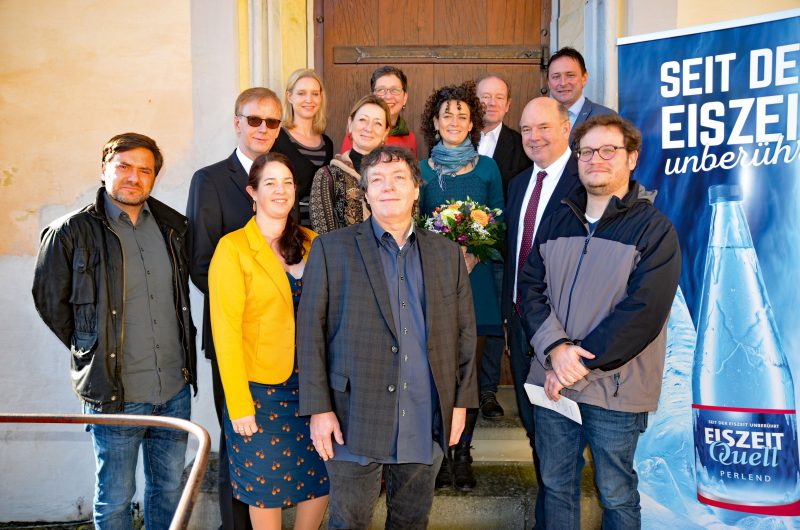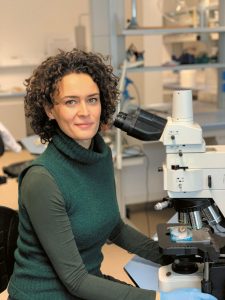Ladies and gentlemen, Prodekan Fortágh, representatives of Romina EiszeitQuell, dear colleagues, students, and friends of the Institute, dear Dr. Venditti,
it is a great honor and pleasure for me to introduce the 22nd laureate of the Tübingen Prize for Early Prehistory and Quaternary Ecology. Over more than twenty years, the prize has been an indicator of the scientific developments in our field. Beside cultural questions about technology, identity, land use, subsistence, and migrations, scientific subjects on the anatomy of different Homo species, aDNA and proteomics, dating, and traceology of artifacts have gained importance. An increasing number of young researchers has combined scientific, cultural, and increasingly digital approaches to expand our knowledge about multifaceted questions. This year’s laureate is one of those candidates with wide-ranging interests. She picked up the issue of recycling, which is currently very popular in the discussion about resource management and the protection of our modern environment, and transferred the concept to the beginning of the Middle Paleolithic. By combining several approaches to create a multi-layered picture of technology and organisation in the production and use of stone implements, Dr. Venditti’s thesis aroused interest during the first round of review of ten doctoral theses evaluated this year. During the detailed review, her approaches and results succeeded in finding high esteem among the referees. Having finished her PhD in Italy, this year’s laureate again broadens the range of countries from which the previous eleven female and ten male awardees come: six were from the USA, five from France, four from Germany, two from Spain and the UK, and one from Denmark and the Netherlands. Many of this long line of promising young scholars now hold permanent positions, have major impact on the development of the field, and support young academics themselves. As always at this point, I would like to express the jury’s gratitude to all of the applicants for their fresh ideas, inspiring work, and fascinating results. The importance of the Tübingen Prize for Early Prehistory and Quaternary Ecology is grounded upon their research. Every year the jury has the privilege to view new approaches and findings. Today it is my honor to present to you, on behalf of the jury and our sponsor, Romina EiszeitQuell, this year’s winner of the award, Dr. Flavia Venditti.

February 6, 2020, at Castle Hohentübingen.
 Flavia Venditti was born in 1986 in Italy. She began her studies in Archaeological Science at the Department of Classics of the University Sapienza of Rome in 2004 and earned her B.A. in 2008 focusing on “Megalithicism in the south of Italy during the Bronze Age”. One year later in 2009, she continued her studies there with a special focus on Prehistoric Archaeology, Experimental Archaeology and Microscopy. She finished her Master’s degree with honors in 2011 with a thesis entitled “Use wear analysis on quartz and quartzite tools, methodology and application. The case study of Coudoulous I (Quercy, France).” From 2011–2014 she took Master’s courses in Cultural Heritage at “La Sapienza” and graduated again with honors with a thesis on “Identification and evaluation of mechanical wear traces on quartz assemblages: The case study of Saï Island, Sudan (VII–V mill. B.C.).” Her Ph.D. project continued the research line of use-wear analysis of stone tools, but led her much deeper into the past. She defended her thesis entitled “The recycling phenomenon during the Lower Palaeolithic: the case study of Qesem Cave (Israel)” at Rome in September 2017. Dr. Venditti is currently a postdoctoral fellow at the University of Tel Aviv, Israel. In collaboration with Prof. Dr. Ran Barkai, she is expanding on her doctoral topic with material from an even older site, Revadim, also in Israel.
Flavia Venditti was born in 1986 in Italy. She began her studies in Archaeological Science at the Department of Classics of the University Sapienza of Rome in 2004 and earned her B.A. in 2008 focusing on “Megalithicism in the south of Italy during the Bronze Age”. One year later in 2009, she continued her studies there with a special focus on Prehistoric Archaeology, Experimental Archaeology and Microscopy. She finished her Master’s degree with honors in 2011 with a thesis entitled “Use wear analysis on quartz and quartzite tools, methodology and application. The case study of Coudoulous I (Quercy, France).” From 2011–2014 she took Master’s courses in Cultural Heritage at “La Sapienza” and graduated again with honors with a thesis on “Identification and evaluation of mechanical wear traces on quartz assemblages: The case study of Saï Island, Sudan (VII–V mill. B.C.).” Her Ph.D. project continued the research line of use-wear analysis of stone tools, but led her much deeper into the past. She defended her thesis entitled “The recycling phenomenon during the Lower Palaeolithic: the case study of Qesem Cave (Israel)” at Rome in September 2017. Dr. Venditti is currently a postdoctoral fellow at the University of Tel Aviv, Israel. In collaboration with Prof. Dr. Ran Barkai, she is expanding on her doctoral topic with material from an even older site, Revadim, also in Israel.
Flavia Venditti’s CV shows a broad diachronic interest from the Bronze Age to the Lower Paleolithic and a geographic range from Italy, France, and the Sudan, to Israel. She gathered practical experience in apprenticeships at the Istituto Superiore per la Conservazione ed il Restauro and the Museo Nazionale Preistorico Etnografico “L. Pigorini” in Rome. As a member of the Programme Collectif de Recherche “Des Traces et des Hommes” directed by Céline Thiébaut and Émilie Claud, she engaged in experimental archaeology. Additionally, she broadened her practical view by getting her hands dirty at several excavations. Since 2012, she is a member of the Qesem Cave Project under the direction of Prof. Dr. Avi Gopher and Prof. Dr. Ran Barkai. The wide range of her activities contributed to the formation of a researcher with a broad international and interdisciplinary view. Flavia Venditti has been active in presenting her work at international conferences and organized a session at the XVIII UISPP Congress in Paris in 2018. She is first author and co-author of several articles in international, high-ranking journals such as Journal of Human Evolution, Journal of Archaeological Science: Reports, Quaternary International, and Scientific Reports.
The Tübingen Prize for Early Prehistory and Quaternary Ecology focuses on Dr. Venditti’s doctoral dissertation entitled “The recycling phenomenon during the Lower Palaeolithic: The case study of Qesem Cave (Israel)” supervised by Prof. Dr. Christina Lemorini from the University “La Sapienza” of Rome. Today, the term ‘recycling’ is associated with the idea of raw material scarcity, of economic or ecological crisis. In World War I and II, recycling of diverse materials became a national obligation out of shortage. Since the 1970s, industrial countries have increasingly drowned in waste, and beside reduction and reuse, recycling became an option again, this time to cope with the undesirable effects of our material wealth. To cite Wikipedia for a current perspective: “Recycling is the process of converting waste materials into new materials and objects. It is an alternative to ‘conventional’ waste disposal that can save material and help lower greenhouse gas emissions. Recycling can prevent the waste of potentially useful materials and reduce the consumption of fresh raw materials, thereby reducing: energy usage, air pollution (from incineration), and water pollution (from landfilling).”1 Flavia Venditti’s research now sheds light on another perspective of recycling, which also increasingly comes into focus in our current times: Items discarded for some purpose are the perfect raw material source for other purposes. To reveal this in times between 400,000 and 240,000 years ago, however, she had to develop a special view on apparently unimpressive artifacts.
The basic elements of Dr. Venditti’s study are small stone flakes produced from discarded ‘parent’ implements. Without retouch, they even do not count as tools in archaeological terminology. Therefore, they have not received much attention: they are of minimal importance in typological studies; the technology of their production is quite simple. They have been considered as archaeological waste in more than one sense. While the technological aspect of recycling has found some recognition, their use and thus the purpose of their production remained obscure. They have been perceived as occasional emergency solutions, when suitable raw material ran short. Yet, Flavia Venditti put a spotlight on these small flakes with the help of microscopy and chemical analyses and showed that the flakes were a common and important part of the Paleolithic toolbox.
Analysing the use wear on the small flakes from Qesem Cave, Dr. Venditti found evidence for the processing of mainly meat, skins and bones when people cut up animals. Rarely, they also worked plants such as tubers. Thanks to the particularly favourable preservation conditions of the cave, residues of the processed materials were also preserved. With the help of microscopic and chemical analyses conducted at the Laboratory of Technological and Functional Analyses of Prehistoric Artifacts led by Prof. C. Lemorini (LTFAPA, Sapienza), remains of bones, animal tissue, and fat could be detected. In experiments, the small sharp tools were particularly suitable for skinning prey and cutting up the cleaned hides. The distribution of these inconspicuous artifacts at the site indicates a clear spatial division of the activities in different areas of the cave. Based on the results of Flavia Venditti’s analyses, we can see the small flakes as ad hoc implements, which the people at Qesem Cave, however, produced systematically for specific purposes. Their desired quality is the very sharp and thin cutting edge, which the people used for specific activities in the process of butchering and hide working. The edges of the implements are brittle and get blunt quickly, but knapping them from discarded ‘parent’ artifacts present everywhere at the site makes them easily accessible when and wherever needed.
It is the great merit of Flavia Venditti’s work that she has drawn attention to the diversity of human actions and considerations as early as 400,000 years ago. People created their toolkit with ad-hoc implements side by side with retouched tools; they processed different kinds of animal and plant tissues for food and other purposes; they varied the management of raw materials and organized their living space. Flavia Venditti should be honored for her broad repertoire of investigative approaches that offer deep insight into less obvious aspects of our ancestors’ lives. Her work points the way to a better understanding of targeted use of resources already present at the end of the Lower Paleolithic. It will be exciting to see how far into the past similar things can be proven with her methods.
Ladies and gentlemen, I hope that this brief introduction has aroused your interest in Dr. Venditti’s research and its significance for early human organisation of daily life. It is my pleasure to introduce our guest of honor, Dr. Flavia Venditti, who will give us a much more in depth presentation about her work. On behalf of the jury and our sponsor, the Romina EiszeitQuell, I would like to express our affectionate congratulations and present to you the 22nd winner of the Tübingen Prize for Early Prehistory and Quaternary Ecology, Dr. Flavia Venditti!